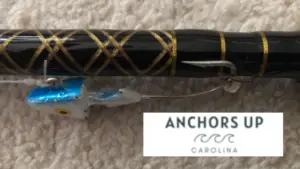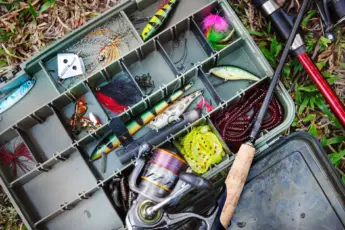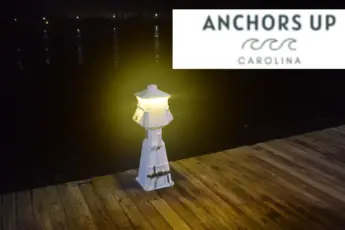Fishing rods are fragile and prone to damage for a multitude of reasons. It is important to take caution when storing rods, transporting fishing rods, and using them while casting or trolling. All avid anglers know that a rod will inevitably become damaged or broken at one point or another. I have broken the tips off rods and bent and snapped off guide eyes. However, one way to significantly reduce the risk of bent or broken eyes is to utilize a fishing rod hook keeper. Here is what to know about fishing rod hook keepers.
What Is A Fishing Rod Hook Keeper
A rod hook keeper comes in multiple forms. Importantly, not all rods are constructed with a hook keeper.
To identify a rod with a hook keeper, look between the forward handle and the first eye. A small half circle metal ring is permanently affixed to the blank. The angler runs the fishing line through the guides with a hook attached at the end and connects the hook to the half circle. Next, once the hook is attached, the line is reeled tight.
Risk Of Failing To Use A Rod Hook Keeper
The purpose of the keeper is to hold the hook or lure and line tight to the rod. A flailing hook not only puts people at risk but is also prone to hooking on other objects and over-flexing the rod if the line comes tight. An over-flexed rod is at risk of snapping in half.
Without question, it is important to use a rod hook keeper when it is available to reduce injury or breakage.
Bending Or Breaking Fishing Rod Eyes
In addition to over-flexing, the rod is breaking or bending fishing rod eyes. Unfortunately, anglers connect fishing hooks and lures to the eyes instead of the rod hook keeper. Once the line is reeled snug, the eye is susceptible to the following damage.
First, the connection point between the eye and the blank is fragile. When a hook or lure is connected to an eye and reeled tightly, the eye is susceptible to bending or snapping off.
Secondly, oftentimes, the inner ring of a rod is lined with a ceramic ring. The ceramic ring is placed specifically to allow the line to flow out of the rod with ease and avoid catching on sharp edges. Hooks and lures not only chip ceramic inserts but also cause them to crack. A chipped ring results in broken fishing lines, whereas missing ceramics impede the line flow while casting or reeling.
Whenever I fish with friends or family, and I am supplying the gear, I am amazed at how many people use guide eyes for hook holders. Without question, I am constantly changing the position of the hook. Fishing gear is expensive, and so are repairs, especially avoidable repairs.
No Fishing Rod Hook Holder No Problem
I’ll admit, its baffling as to why some rod manufacturers do not include a hook holder. However, if you’re rod is not fitted with a holder, solutions are available.
Fortunately, aftermarket hook holders are available; however, they do not look quite as seamless as rods designed with a hook holder. But they serve the purpose of keeping your equipment safe.
To better understand, an aftermarket hook holder is the combination of an elastic band combined with a plastic eye ring. The eye is fitted with two round rubber circles, and the elastic band connects to each side, thus securing the hook holder to the rod.
Often, fishing rods are finished with colored design work, making them more visually appealing. Fortunately, the aftermarket rod hook holders come in a multitude of colors. That said, you can select a rod hook holder color pattern that best matches your rods.
I recommend the JueDi Fishing Rod Hook Keeper. The keepers are sold in packs of four or packs of eight. Importantly, the hook holders are fairly priced, considering how much fishing gear and accessories cost these days.
I’ll admit, at times, the hook holders fall off, especially when the rods are banged around or are wet. It is not a bad idea to keep a few extra on hand and stow them away in the fishing bag. If one disappears, you have a backup ready to go.
Use Your Fishing Rod Hook Keeper
Without a doubt, if your rod is fitted with a hook keeper, use it each and every time you’re done casting. However, if your rods lack a hook holder, add an aftermarket keeper. Rods are expensive and are best to be taken care of appropriately. Also, if you spot hooks connected to the eyes, change before you get underway on a boat or by foot. The movement will cause further damage to delicate eye ceramics.







